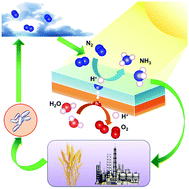当前位置:
X-MOL 学术
›
Mater. Horiz.
›
论文详情
Our official English website, www.x-mol.net, welcomes your feedback! (Note: you will need to create a separate account there.)
Photocatalytic fixation of nitrogen to ammonia: state-of-the-art advancements and future prospects
Materials Horizons ( IF 13.3 ) Pub Date : 2017-08-29 00:00:00 , DOI: 10.1039/c7mh00557a Xingzhu Chen 1, 2, 3, 4 , Neng Li 1, 2, 3, 4, 5 , Zhouzhou Kong 1, 2, 3, 4 , Wee-Jun Ong 6, 7, 8, 9, 10 , Xiujian Zhao 1, 2, 3, 4
Materials Horizons ( IF 13.3 ) Pub Date : 2017-08-29 00:00:00 , DOI: 10.1039/c7mh00557a Xingzhu Chen 1, 2, 3, 4 , Neng Li 1, 2, 3, 4, 5 , Zhouzhou Kong 1, 2, 3, 4 , Wee-Jun Ong 6, 7, 8, 9, 10 , Xiujian Zhao 1, 2, 3, 4
Affiliation

|
The burgeoning development of ammonia (NH3) synthesis technology addresses the urgency of food intake required to sustain the population growth of the last 100 years. To date, NH3 has mostly been synthesized by the Haber–Bosch process in industry. Under the ever-increasing pressure of the fossil fuel depletion crisis and anthropogenic global climate change with continuous CO2 emission in the 21st century, research targeting the synthesis of NH3 under mild conditions in a sustainable and environment friendly manner is vigorous and thriving. Therefore, the focus of this review is the state-of-the-art engineering of efficient photocatalysts for dinitrogen (N2) fixation toward NH3 synthesis. Strenuous efforts have been devoted to modifying the intrinsic properties of semiconductors (i.e. poor electron transport, rapid electron–hole recombination and sluggish reaction kinetics), including nanoarchitecture design, crystal facet engineering, doping and heterostructuring. Herein, this review provides insights into the most recent advancements in understanding the charge carrier kinetics of photocatalysts with respect to charge transfer, migration and separation, which are of fundamental significance to photocatalytic N2 fixation. Subsequently, the challenges, outlooks and future prospects at the forefront of this research platform are presented. As such, it is anticipated that this review will shed new light on photocatalytic N2 fixation and NH3 synthesis and will also provide a blueprint for further investigations and momentous breakthroughs in next-generation catalyst design.
中文翻译:

氮到氨的光催化固定:最新进展和未来前景
氨(NH 3)合成技术的迅速发展解决了维持过去100年人口增长所需的食物摄取的紧迫性。迄今为止,NH 3大部分是通过工业上的Haber-Bosch工艺合成的。在21世纪持续增长的化石燃料枯竭危机和人为全球气候变化的压力下,持续的CO 2排放,以温和条件下以可持续,环境友好的方式合成NH 3的研究蓬勃发展。因此,本综述的重点是用于将二氮(N 2)固定为NH 3的有效光催化剂的最新技术合成。艰苦的努力已经致力于修改半导体的固有性质(即差的电子传输,快速电子-空穴复合和迟缓反应动力学),包括纳米架构设计,晶面工程,掺杂和heterostructuring。在此,本综述提供了对了解光催化剂在电荷转移,迁移和分离方面的电荷载流子动力学的最新进展的见解,这对于光催化N 2固定至关重要。随后,介绍了该研究平台最前沿的挑战,前景和未来前景。因此,预计该评论将为光催化N 2提供新的思路。固定和NH 3合成,还将为进一步研究和在下一代催化剂设计中取得重大突破提供蓝图。
更新日期:2017-08-29
中文翻译:

氮到氨的光催化固定:最新进展和未来前景
氨(NH 3)合成技术的迅速发展解决了维持过去100年人口增长所需的食物摄取的紧迫性。迄今为止,NH 3大部分是通过工业上的Haber-Bosch工艺合成的。在21世纪持续增长的化石燃料枯竭危机和人为全球气候变化的压力下,持续的CO 2排放,以温和条件下以可持续,环境友好的方式合成NH 3的研究蓬勃发展。因此,本综述的重点是用于将二氮(N 2)固定为NH 3的有效光催化剂的最新技术合成。艰苦的努力已经致力于修改半导体的固有性质(即差的电子传输,快速电子-空穴复合和迟缓反应动力学),包括纳米架构设计,晶面工程,掺杂和heterostructuring。在此,本综述提供了对了解光催化剂在电荷转移,迁移和分离方面的电荷载流子动力学的最新进展的见解,这对于光催化N 2固定至关重要。随后,介绍了该研究平台最前沿的挑战,前景和未来前景。因此,预计该评论将为光催化N 2提供新的思路。固定和NH 3合成,还将为进一步研究和在下一代催化剂设计中取得重大突破提供蓝图。



























 京公网安备 11010802027423号
京公网安备 11010802027423号